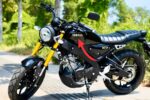Mahindra XUV700: The Mahindra XUV700 represents a significant milestone in the evolution of the Indian automotive industry, demonstrating how domestic manufacturers can deliver products that combine global standards with specific adaptations for local requirements.
Launched in 2021 as a successor to the popular XUV500, this vehicle showcases Mahindra’s growing engineering sophistication and brand ambition.
Through thoughtful feature integration and value-focused positioning, the XUV700 has established new expectations within its segment.
Mahindra XUV700: Design Philosophy and Exterior Aesthetics
The XUV700’s exterior design balances contemporary styling with road presence appropriate for its segment positioning.
The front fascia features distinctive C-shaped LED daytime running lights flanking a six-slat grille with the new Mahindra logo, creating immediate brand recognition.
The clean body lines and sculpted surfaces reflect modern design sensibilities while maintaining visual mass appropriate for an SUV.
Available in multiple color options including Deep Forest, Midnight Black, Red Rage, and Everest White, the exterior finish provides meaningful personalization opportunities.
Dimension-wise, the vehicle measures 4,695mm in length, 1,890mm in width, and 1,755mm in height, with a wheelbase of 2,750mm.
These proportions deliver substantial road presence while maintaining reasonable maneuverability for urban environments.
The lighting system incorporates all-LED technology with automatic functionality on higher variants, providing superior illumination compared to halogen alternatives common in this segment.
The alloy wheel designs (17-inch or 18-inch depending on variant) feature contemporary patterns that complement the overall design language while providing practical benefits regarding brake cooling and structural integrity.
Interior Design and Technology
The cabin design represents perhaps the most dramatic advancement over previous Mahindra offerings, featuring a horizontally-oriented dashboard with twin 10.25-inch displays creating a panoramic screen effect.
This arrangement incorporates both driver instrumentation and infotainment functions within a visually cohesive implementation that establishes immediate perceived value.
The seating configuration accommodates either six or seven occupants depending on variant, with second-row captain chairs or bench seating available.
Front passengers benefit from leatherette upholstery on higher variants with power adjustment for the driver’s position.
The second row features adjustable seating with substantial legroom, while the third row provides acceptable accommodation for occasional use—a reasonable compromise in this vehicle category.
Material selection balances durability with visual appeal, utilizing soft-touch materials for primary contact surfaces while incorporating piano black and aluminum-finish trim elements that elevate the perceived quality. The overall execution represents significant improvement over previous Mahindra interiors, though still reflecting value-oriented design choices appropriate to the vehicle’s positioning.
Technology Integration
The technology package centers around the aforementioned twin-screen implementation branded as “AdrenoX,” featuring wireless Apple CarPlay and Android Auto connectivity.
The interface design prioritizes legibility and straightforward operation with customizable layouts.
The infotainment system incorporates voice recognition through Alexa integration, allowing natural language control of various vehicle functions.
Advanced driver assistance systems represent a particular highlight, with the XUV700 introducing features previously uncommon in Indian-manufactured vehicles.
These include adaptive cruise control, autonomous emergency braking, lane keeping assistance, and driver attention monitoring.
The Level 2 ADAS implementation acknowledges growing consumer interest in safety technology while delivering practical functionality adapted for Indian driving conditions.
Convenience features include a panoramic sunroof, wireless charging pad, multi-zone climate control, and a premium 12-speaker Sony audio system on higher variants.
The integrated connected car technology provides remote vehicle monitoring, geofencing capabilities, and over-the-air update functionality for both infotainment and vehicle systems.
Chassis and Mechanical Architecture
The XUV700 utilizes a monocoque construction that balances structural rigidity with weight optimization, delivering improved dynamics compared to body-on-frame alternatives.
The suspension architecture employs independent MacPherson struts at the front and a multi-link arrangement at the rear, providing reasonable articulation capability while prioritizing on-road comfort.
Available in both front-wheel drive and all-wheel drive configurations, the vehicle offers flexibility across different price points and capability requirements.
The all-wheel drive system features electronically controlled torque distribution with terrain management modes that modify throttle response, stability control parameters, and power delivery according to surface conditions.
The braking system incorporates all-wheel disc brakes with electronic assistance features including ABS, electronic brake-force distribution, and electronic stability control—features increasingly expected rather than exceptional in this segment.
The steering system provides reasonable feedback while prioritizing ease of operation in urban environments.
Powertrain Options and Performance
The XUV700 offers two primary powertrain options reflecting different consumer priorities. The 2.0-liter mStallion turbocharged petrol engine produces 200 horsepower and 380 Nm of torque, delivering responsive performance particularly valuable for urban and highway driving.
This relatively sophisticated direct-injection unit provides reasonable efficiency despite the vehicle’s substantial dimensions.
The 2.2-liter mHawk diesel engine generates 155 horsepower (175 horsepower in higher variants) and up to 450 Nm of torque, emphasizing low-end torque delivery particularly beneficial during fully-loaded driving conditions.
This diesel option particularly appeals to buyers prioritizing long-distance touring efficiency and towing capability.
Both engines offer six-speed manual or automatic transmission options, providing choices across different driving preferences and budget considerations.
The automatic variants include drive modes (Zip, Zap, and Zoom) that modify throttle response and transmission behavior according to driver priorities, enhancing the vehicle’s versatility across varied driving scenarios.
Mahindra XUV700:
The Mahindra XUV700 represents a significant achievement in indigenous vehicle development, demonstrating how domestic manufacturers can create compelling propositions that balance global standards with market-specific adaptations.
By offering advanced safety technology, contemporary design, and reasonable performance at accessible price points, Mahindra has established new expectations within the Indian SUV segment.
The vehicle’s market reception validates this approach, with strong demand despite component shortages and production constraints.
For consumers seeking substantial road presence, practical family accommodation, and modern technology without the premium pricing of international brands, the XUV700 delivers a compelling value proposition that reinforces Mahindra’s growing reputation for meaningful innovation within the competitive Indian automotive landscape.





